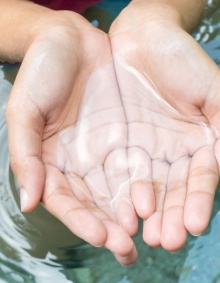A natural fit: social work and environmental justice
School of Social Work Global Interest Group annual symposium highlights

By Jana Eisenberg
Ticking off a list of recent and ongoing national and global environmental challenges, and thinking about those who suffer the most as a result of them, makes it obvious that social work and environmental justice are inextricably linked.
Social workers are increasingly turning their attention to environmental justice and to those affected by disasters. A consistent theme is many cultures’ deep connections with natural elements like water and land. The school’s Global Interest Group emphasized this connection with their third annual symposium, “Water, the Environment and a Socially Just World,” which was held in March at the UB South Campus.
Organizers included a diverse selection of topics and presenters, from the local to the global, including a performance of a Burmese water dance, and representatives from the Seneca Nation who spoke of their roles as water protectors. Professor and Associate Dean for Academic Affairs Hilary Weaver, one of the organizers, who is Lakota, spoke at the opening of the day-long session. She pointed out that many cultures revere the earth and all the natural elements as sacred, both giving life and deserving respect and nurturing.
In her welcoming comments, Dean Nancy J. Smyth pointed out that modern social work has roots in environmental justice: Jane Addams fought for better employee working and living environments in the late 19th century.
A more modern advocate for intervention at the environmental level is symposium speaker Cathryne Schmitz. A professor at University of North Carolina Greensboro, Schmitz is active in educating about how climate change, violence and their effects disproportionately affect young people, poor people, people of color, women, immigrants and refugees.
“I’ve struggled with how to share information about climate change,” she said. “There is lots of data, and no doubt that humans are impacting the environment. But data doesn’t move people. How do we get people to feel passion and urgency? Not by making them anxious, but with compassion and empathy.”
She urges people to connect through stories and feelings. “What matters to you the most? Simple and beautiful memories—water, moss, plants? The coast or wildlife? People will get involved if it’s personal,” she continued. “Things in our society like money and debt are social constructs—they aren’t real in the same way that the earth and water are. We can’t afford to destroy the earth; we don’t have a spare.”
Shanondora Billiot, assistant professor at University of Illinois and a member of the United Houma Nation, discussed her PhD, “Environmental Changes and Indigenous Peoples: The Interconnectedness of Land Loss, Shared Cultural Experiences, and Trauma.” Tribal elders asked her to examine the effects of chronic land loss on the people and community, rather than her intended topic, mental health and behavior.
Billiot addressed the negative effects of colonialism on indigenous people, and specifically the Houma Nation. She also introduced the phrase “climate refugee.” This and phrases like it (“climate migrant”) are becoming more commonly used. They describe people who are forced to leave their homes because of the effects of environmental changes, often accompanied by rising regional tension or conflict as resources dwindle.
Human influence on the environment—for oil company profits—caused community displacement for the Houma, said Billiot, worsening public health and a shift from their ability to rely on natural resources for their traditional way of life, including culturally, socially and spiritually.
When an environmental disaster hits a community, like poisoned water in Flint, said symposium speakers Assistant Professor Tam Perry and research assistant Max Smith of Wayne State University, it’s important to look at all sectors. They studied the effect of the crisis on older adults, through the lens of years of broken systems and systematic racism which led to the ongoing circumstances.
Through interviews, Perry and Smith learned that the lack of clean, drinkable water, and untrustworthiness of institutions that are supposed to protect them is deeply affecting every aspect of people’s lives. There is rising anxiety over how to get water, and where to store it. Meal preparation becomes challenging, affecting everyday life as well as, for example, the way that traditional holidays or events are celebrated. Illness as a result of attempting to wash with the tainted water, rashes and itching continue. And it mostly affects poor people and those of color.
Panels moderated by Assistant Professor Shaanta Murshid brought an even broader perspective. In addition to Sheila Saia, a U.S. Forest Service environmental engineer based in North Carolina who focuses on climate change response, UB researchers Nirupam Aich and Emmanuel Boamah discussed their work; Aich in nano-technology and global electronic waste and Boamah on farmers’ land and water rights in Ghana. In the next panel, members of the Seneca Nation, Jason Corwin, Clarence Seneca, Darelyn Spruce and Nicky Thompson discussed their roles as water protectors and activists.
In her closing remarks at the end of the intense day, Weaver summed up: “We need to pay attention to what and who is and isn’t valued. We can look at how we are harming the earth, and how we may be feeding into the lies we’ve been fed. In every single culture, there are complimentary perspectives about environmental or water issues. And it’s not just a matter of justice, it’s a matter of survival.”